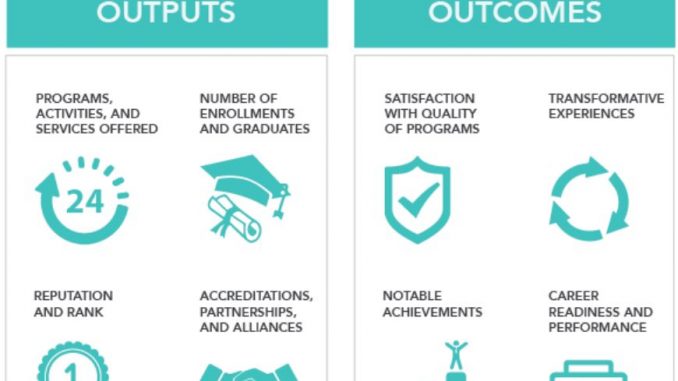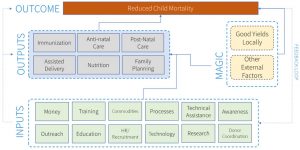
Both outputs and outcomes are the result of the project. Therefore, we usually use these words interchangeably. However, there are distinct differences between output and outcome. Let’s have a look at these differences.
Table of Contents
Fifteen (15) Differences Between Outputs and Outcomes:
| Outputs | Outcomes |
| Outputs are achieved immediately after implementing an activity or a project/programs. | Outcomes are not achieved right after the implementation of activities or projects/programs. |
| Output is what is created at the end of a process. | Outcome is the level of performance or achievement that occurred because of the activity or programs. |
| Outputs are immediate results. Often referred as first level results. | Outcomes are short term or mid-term results. Often referred as second level results. |
| Output is linked to activities. Output indicates completion of a project/programs activities. | Outcome is linked to objectives. Outcome indicates achievement of a project/programs. |
| Outputs are easy to measure/report or validate. They are usually tangible. | Outcomes are difficult to measure or validate. They are usually intangible. |
| Outputs are the means to end. These are actions/items that contribute to achieve an outcome. | Outcomes are the end results. Outcomes are what a project/business wants/desires to achieve. |
| Outputs do not show the level of performance/achievement. | Outcome shows the level of achievement due to the of activity/services provided. |
| Outputs result into outcome. | Outcome are the result of output. i.e. they are achieved after the output. |
| Outputs are within direct control of the program/program managers. | Outcomes are not within direct control of the program/program managers. |
| Outputs can be CONTROLLED by the program. | Outcomes can only be INFLUENCED by the program. |
| Outputs are not the reason for designing a project. | Outcomes are the reason for the designing a project. |
| Outputs are not the measure for effectiveness. | Effectiveness, efficacy and efficiency are used to measure outcomes. |
| Output measures do not address the value or impact of your services for your clients. | Outcome are supposed to address the value of the services/activities. |
| Outputs are usually measured in numbers. E.g.: 100 people trained in prevention of corona virus, 95 graduates of the school etc. | Outcomes cannot be generally measured in numbers. It is a change that occurs because of the program. |
| Outputs are the immediate result of our action. It takes less time to accomplish. | Outcomes are the differences made by the outputs. It takes more time to accomplish. |
Some examples of output of a HIV/AIDS program are:
|
Some examples of outcome of a HIV/AIDS program are:
|
*Efficiency: Efficiency is defined as functioning in an optimum level with the least waste of time.
Efficacy: Efficacy is a capacity to produce a desired or intended result.
Effectiveness: Effectiveness describes getting an outcome even if it is time-consuming.

Let us also have a look at project wise differences between outputs and outcomes.
Examples of Project Wise Differences between Output and Outcome:
| Difference based on Project | Outputs | Outcomes |
| Disaster relief | Provided 200 blankets to earthquake victims. | Beneficiaries stay warm, more comfortably, and are less likely to become sick. |
| Health and nutrition | Supplied 10,000 packets of supplementary food to the children under five years of age | Lowered cases of acute malnutrition among children under five years of age. |
| Business |
|
|
| Education | Trained 100 primary school teachers of Early Childhood Development. | These 100 teachers educated 2500 pupils, enabling these children to find better jobs and move on to higher-level education |
| Policy | Prepared a policy document to decrease hunger. | Interventions designed and implemented (as per the policy document) to decrease hunger |
| Human rights | Organized an international conference for indigenous peoples around the world. | Provided a safe space for human rights leaders to meet, share information, and partner to improve the efficacy of their actions. |
Bonus information:
Let’s know slightly about ‘IMPACT’ as well !
What do you mean by ‘impact’ in project management?
- An ‘Impact’ is generally a long-term result in a situation and it might not be attainable even during the project life cycle.
- For example: If the community has achieved its goal of getting their human rights recognized by the government, then it is an impact created by the project though it is usually seen after several years.
References and For More Information:
https://en.oxforddictionaries.com/definition/output
https://dictionary.cambridge.org/dictionary/english/output
https://www.vocabulary.com/dictionary/outcome
https://www.sysaid.com/blog/entry/the-difference-between-outcomes-and-outputs-makes-a-difference
https://proposalsforngos.com/whats-the-difference-project-outputs-vs-outcomes/
http://www.differencebetween.net/language/difference-between-output-and-outcome/
https://measurementresourcesco.com/2014/02/02/outputs-vs-outcomes-matters/
http://www.differencebetween.net/language/difference-between-output-and-outcome/
https://www.bmc.com/blogs/outcomes-vs-outputs/
https://www.thebalancesmb.com/inputs-outputs-outcomes-impact-what-s-the-difference-2502227